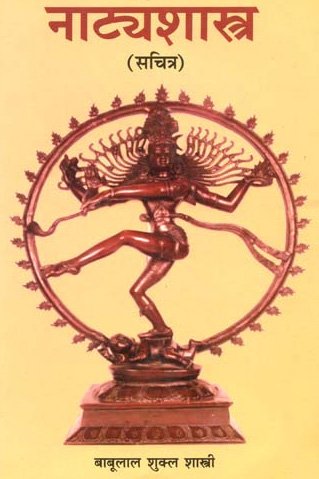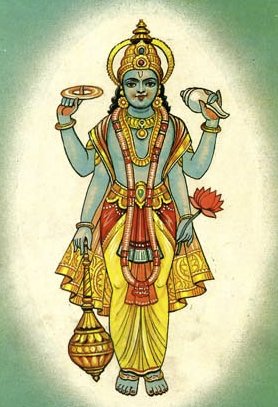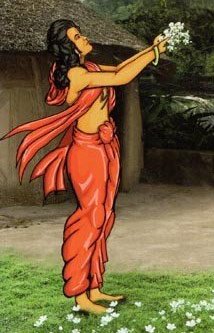Vismaya: 22 definitions
Introduction:
Vismaya means something in Hinduism, Sanskrit, Marathi, Hindi. If you want to know the exact meaning, history, etymology or English translation of this term then check out the descriptions on this page. Add your comment or reference to a book if you want to contribute to this summary article.
Alternative spellings of this word include Vismay.
In Hinduism
Natyashastra (theatrics and dramaturgy)
Source: Wisdom Library: Nāṭya-śāstraVismaya (विस्मय, “astonishment”).—One of the eight ‘permanent states’ (sthāyibhāva), according to the Nāṭyaśāstra chapter 7.31. These ‘permanent states’ are called ‘the source of delight’ and are not interfered with by other States. The term is used throughout nāṭyaśāstra literature. (Also see the Daśarūpa 4.43-44)
Source: archive.org: The mirror of gesture (abhinaya-darpana)A type of glance (or facial expression): Viṣmaya (astonishment): quickly raised, straight-staring. Usage: astonishment.
Source: archive.org: Natya ShastraVismaya (विस्मय, “astonishment”) is created by determinants (vibhāva) such as illusion, magic, extraordinary feats of men, great excellence in painting, art-works in parchment and the like. It is to be represented on the stage by consequents (anubhāva) such as wide opening of the eyes, looking without winking of the eyes, [much] movement of the eyebrows, horripilation, moving the head to and fro, the cry of “well done,” “well done,” and the like.
Source: Shodhganga: Elements of Art and Architecture in the Trtiyakhanda of the Visnudharmottarapurana (natya)Vismaya (विस्मय) or “wonder” is the sthāyībhāva (“durable psychological state”) associated with Adbhuta or the “wonderful sentiment”, which represents one of the nine kinds of Rasa (“soul of Drama”), according to the Viṣṇudharmottarapurāṇa, an ancient Sanskrit text which (being encyclopedic in nature) deals with a variety of cultural topics such as arts, architecture, music, grammar and astronomy.—According to the Viṣṇudharmottarapurāṇa, Adbhuta is the sentiment that arises from wonder. Vismaya is the sthāyibhāva of adbhuta-rasa. Pīta i.e., yellow is the colour and Brahma is the god of this sentiment. The Viṣṇudharmottarapurāṇa states that adbhutarasa arises from vīrarasa.

Natyashastra (नाट्यशास्त्र, nāṭyaśāstra) refers to both the ancient Indian tradition (shastra) of performing arts, (natya—theatrics, drama, dance, music), as well as the name of a Sanskrit work dealing with these subjects. It also teaches the rules for composing Dramatic plays (nataka), construction and performance of Theater, and Poetic works (kavya).
Shilpashastra (iconography)
Source: Shodhganga: The significance of the mūla-beras (śilpa)Vismaya (विस्मय) or Vismayahasta refers to “surprise” and represents one of the twenty-four gestures with a single hand, as defined according to texts dealing with śilpa (arts and crafs), known as śilpaśāstras.—Accordingly, pratimā-lakṣaṇa (body postures of the icons) is comprised of hand gestures (hasta, mudrā or kai-amaiti), stances/poses (āsanas) and inflexions of the body (bhaṅgas). There are thirty-two types of hands [viz., vismaya-hasta] classified into two major groups known as tolirkai (functional and expressive gestures) and elirkai (graceful posture of the hand).

Shilpashastra (शिल्पशास्त्र, śilpaśāstra) represents the ancient Indian science (shastra) of creative arts (shilpa) such as sculpture, iconography and painting. Closely related to Vastushastra (architecture), they often share the same literature.
Vaishnavism (Vaishava dharma)
Source: Pure Bhakti: Bhagavad-gita (4th edition)Vismaya (विस्मय) refers to “wonder”. (cf. Glossary page from Śrīmad-Bhagavad-Gītā).

Vaishnava (वैष्णव, vaiṣṇava) or vaishnavism (vaiṣṇavism) represents a tradition of Hinduism worshipping Vishnu as the supreme Lord. Similar to the Shaktism and Shaivism traditions, Vaishnavism also developed as an individual movement, famous for its exposition of the dashavatara (‘ten avatars of Vishnu’).
Kavya (poetry)
Source: academia.edu: Bhoja’s Mechanical GardenVismaya (विस्मय) refers to the “emotion of astonishment”.—The accounts of both the Śṛṅgāra-mañjarīkathā and Yaśastilakacampū depict real living animals as being charmed or fooled by the automata as if they were alive. A key source of the machine’s fascination, then, was its ability to create deception. Dramaturgical and aesthetic texts in the Sanskrit courtly traditions understood the emotion of astonishment (vismaya) as having its causal basis not only in extraordinary phenomena like the great acts of men, in unusual painting and parchment, but also in illusion and magic—arts that relied on the concealment of causes.

Kavya (काव्य, kavya) refers to Sanskrit poetry, a popular ancient Indian tradition of literature. There have been many Sanskrit poets over the ages, hailing from ancient India and beyond. This topic includes mahakavya, or ‘epic poetry’ and natya, or ‘dramatic poetry’.
Purana and Itihasa (epic history)
Source: archive.org: Shiva Purana - English TranslationVismaya (विस्मय) refers to “surprise and wonder”, and is used to describe the mountain Kailāsa (the auspicious excellent mountainous abode of Śiva), according to the Śivapurāṇa 2.2.40.—Accordingly, as Brahmā narrated to Nārada:—“[...] accompanied by the gods, sages, Brahmā and others Viṣṇu went to Kailāsa, the auspicious excellent mountainous abode of Śiva. [...] Kailāsa was infested with big animals (i.e., vyāghra-ādi), tigers and others who were free from cruelty. It was of divine nature endowed with shining brilliance. It inspired great surprise and wonder (mahā-vismaya-kāraka)”.

The Purana (पुराण, purāṇas) refers to Sanskrit literature preserving ancient India’s vast cultural history, including historical legends, religious ceremonies, various arts and sciences. The eighteen mahapuranas total over 400,000 shlokas (metrical couplets) and date to at least several centuries BCE.
Shaktism (Shakta philosophy)
Source: Google Books: ManthanabhairavatantramVismaya (विस्मय) refers to “(great) wonder”, according to the Kularatnoddyota verse 2.21-27.—Accordingly, “[...] O Bhairavī, once the lord had made the three vessels in this sequence, he worshipped the Wheel by acting (freely) as he desired. Seeing the Lord of the Wheel within the Wheel intent on worship, the Supreme goddess, her mind full of humility, asked (him): ‘O god and lord, what is worshipped in the great union that arouses great wonder (mahāvismaya-kāraka) with (all this) great heap of sacrificial substances and the divine wheels that generate great bliss? Śrīnātha, if you do (indeed) bestow boons tell (me this) by (your) grace’”.

Shakta (शाक्त, śākta) or Shaktism (śāktism) represents a tradition of Hinduism where the Goddess (Devi) is revered and worshipped. Shakta literature includes a range of scriptures, including various Agamas and Tantras, although its roots may be traced back to the Vedas.
Languages of India and abroad
Marathi-English dictionary
Source: DDSA: The Molesworth Marathi and English Dictionaryvismaya (विस्मय).—m (S) Astonishment, surprise, wonder. v hō, vāṭa.
Source: DDSA: The Aryabhusan school dictionary, Marathi-Englishvismaya (विस्मय).—m Astonishment, wonder, surprise.
Marathi is an Indo-European language having over 70 million native speakers people in (predominantly) Maharashtra India. Marathi, like many other Indo-Aryan languages, evolved from early forms of Prakrit, which itself is a subset of Sanskrit, one of the most ancient languages of the world.
Sanskrit dictionary
Source: DDSA: The practical Sanskrit-English dictionaryVismaya (विस्मय).—
1) Wonder, surprise, astonishment, amazement; पुरुषः प्रबभूवाग्नेर्विस्मयेन सहर्त्विजाम् (puruṣaḥ prababhūvāgnervismayena sahartvijām) R.1.5.
2) Astonishment or wonder, being the feeling which produces the adbhuta sentiment; S. D. thus defines it :विविधेषु पदार्थेषु लोकसीमातिवर्तिषु । विस्फारश्चेतसो यस्तु स विस्मय उदाहृतः (vividheṣu padārtheṣu lokasīmātivartiṣu | visphāraścetaso yastu sa vismaya udāhṛtaḥ) || 27.
3) Pride, arrogance; तपः क्षरति विस्मयात् (tapaḥ kṣarati vismayāt) Manusmṛti 4.237.
4) Uncertainty, doubt.
Derivable forms: vismayaḥ (विस्मयः).
Source: Cologne Digital Sanskrit Dictionaries: Shabda-Sagara Sanskrit-English DictionaryVismaya (विस्मय).—m.
(-yaḥ) 1. Wonder, surprise, astonishment, (wonder or admiration considered as the feeling giving rise to the Adbhuta Sentiment.) 2. Pride, arrogance. 3. Doubt, uncertainty. E. vi before, smi to smile, aff. ac .
Source: Cologne Digital Sanskrit Dictionaries: Benfey Sanskrit-English DictionaryVismaya (विस्मय).—i. e. vi-smi + a, m. 1. Surprise, [Vikramorvaśī, (ed. Bollensen.)] 78, 5; wonder, [Pañcatantra] i. [distich] 459 (bālake ko tra vismayaḥ, literally, What wonder concerning a little boy, i. e. how much more a little boy). 2. Pride, [Mānavadharmaśāstra] 4, 237. 3. Doubt, uncertainty, [Hitopadeśa] 13, 19; perplexity, [Hitopadeśa] ii. [distich] 13.
Source: Cologne Digital Sanskrit Dictionaries: Cappeller Sanskrit-English DictionaryVismaya (विस्मय).—[masculine] na [neuter] wonder, surprise.
Source: Cologne Digital Sanskrit Dictionaries: Monier-Williams Sanskrit-English Dictionary1) Vismaya (विस्मय):—[=vi-smaya] [from vi] 1. vi-smaya mfn. (for 2. See vi-√smi) free from pride or arrogance, [Bhāgavata-purāṇa; Śiśupāla-vadha]
2) [=vi-smaya] [from vi-smi] 2. vi-smaya m. (for 1. See p. 953, col. 1) wonder, surprise, amazement, bewilderment, perplexity (in [rhetoric] one of the sthāyi-bhāvas q.v.), [Mahābhārata; Kāvya literature; Daśarūpa]
3) [v.s. ...] pride, arrogance, [Manu-smṛti; Bhāgavata-purāṇa]
4) [v.s. ...] doubt, uncertainty, [Horace H. Wilson]
Source: Cologne Digital Sanskrit Dictionaries: Yates Sanskrit-English DictionaryVismaya (विस्मय):—[vi-smaya] (yaḥ) 1. m. Wonder, surprise; pride; doubt.
Source: DDSA: Paia-sadda-mahannavo; a comprehensive Prakrit Hindi dictionary (S)Vismaya (विस्मय) in the Sanskrit language is related to the Prakrit word: Vimhaya.
[Sanskrit to German]
Sanskrit, also spelled संस्कृतम् (saṃskṛtam), is an ancient language of India commonly seen as the grandmother of the Indo-European language family (even English!). Closely allied with Prakrit and Pali, Sanskrit is more exhaustive in both grammar and terms and has the most extensive collection of literature in the world, greatly surpassing its sister-languages Greek and Latin.
Hindi dictionary
Source: DDSA: A practical Hindi-English dictionaryVismaya (विस्मय) [Also spelled vismay]:—(nm) wonder, surprise, astonishment, amazement; ~[kara/kārī/janaka] wonderful, surprising, amazing; sensational.
...
Kannada-English dictionary
Source: Alar: Kannada-English corpusVismaya (ವಿಸ್ಮಯ):—
1) [noun] a person, thing or event that causes astonishment and admiration; a prodigy; a marvel; a wonder.
2) [noun] offensive display of superiority or self-importance; overbearing pride; arrogance.
3) [noun] (rhet.) a sentiment of reverence, fear, and wonder, caused by something majestic, sublime, sacred, etc.
Kannada is a Dravidian language (as opposed to the Indo-European language family) mainly spoken in the southwestern region of India.
Nepali dictionary
Source: unoes: Nepali-English DictionaryVismaya (विस्मय):—n. 1. wonder; surprise; astonishment; amazement; 2. astonishment or wonder being the feeling which produces the addhuta sentiment;
Nepali is the primary language of the Nepalese people counting almost 20 million native speakers. The country of Nepal is situated in the Himalaya mountain range to the north of India.
See also (Relevant definitions)
Starts with (+19): Vismaya Mudra, Vismayabadu, Vismayabharita, Vismayabharite, Vismayadibodhaka, Vismayagol, Vismayagollu, Vismayaharshamula, Vismayahasta, Vismayakar, Vismayakara, Vismayakaraka, Vismayakari, Vismayakarin, Vismayakarshamula, Vismayakramta, Vismayakramte, Vismayakula, Vismayalocana, Vismayambade.
Ends with: Agatavismaya, Ativismaya, Kritavismaya, Mahavismaya, Savismaya, Suvismaya.
Full-text (+59): Vismayin, Vismayakula, Kritavismaya, Savismaya, Vismayamgama, Vismayanvita, Brahmya, Sthayibhava, Vismayavishta, Savismayam, Vismayavat, Vismayakarin, Vismayavishadavat, Vismayaharshamula, Vismayakara, Vismayamkara, Vimhaya, Vismayana, Vismayaniya, Vismayotphullanayana.
Relevant text
Search found 30 books and stories containing Vismaya, Vi-smaya; (plurals include: Vismayas, smayas). You can also click to the full overview containing English textual excerpts. Below are direct links for the most relevant articles:
Garga Samhita (English) (by Danavir Goswami)
Verse 2.23.16 < [Chapter 23 - The Killing of Śaṅkhacūḍa During the Rāsa-dance Pastime]
Verse 2.22.30 < [Chapter 22 - The Rāsa-dance Pastime]
Verse 3.5.19 < [Chapter 5 - The Dispute Among the Gopas]
Brihad Bhagavatamrita (commentary) (by Śrī Śrīmad Bhaktivedānta Nārāyana Gosvāmī Mahārāja)
Verse 2.3.52 < [Chapter 3 - Bhajana (loving service)]
Verse 2.1.57-59 < [Chapter 1 - Vairāgya (renunciation)]
Verse 2.2.37 < [Chapter 2 - Jñāna (knowledge)]
Bhakti-rasamrta-sindhu (by Śrīla Rūpa Gosvāmī)
Verse 2.5.55 < [Part 5 - Permanent Ecstatic Mood (sthāyī-bhāva)]
Verse 4.2.12 < [Part 2 - Astonishment (adbhuta-rasa)]
Verse 2.5.40 < [Part 5 - Permanent Ecstatic Mood (sthāyī-bhāva)]
Shrimad Bhagavad-gita (by Narayana Gosvami)
Verse 11.14 < [Chapter 11 - Viśvarūpa-darśana-yoga (beholding the Lord’s Universal Form)]
Verse 18.77 < [Chapter 18 - Mokṣa-yoga (the Yoga of Liberation)]
Verse 11.8 < [Chapter 11 - Viśvarūpa-darśana-yoga (beholding the Lord’s Universal Form)]
Sahitya-kaumudi by Baladeva Vidyabhushana (by Gaurapada Dāsa)
Text 4.37 < [Chapter 4 - First-rate Poetry]
Text 7.131 < [Chapter 7 - Literary Faults]
Text 4.46 < [Chapter 4 - First-rate Poetry]
The Tattvasangraha [with commentary] (by Ganganatha Jha)
Verse 2243 < [Chapter 24a - The case for the reliability of the Veda (the Revealed Word)]